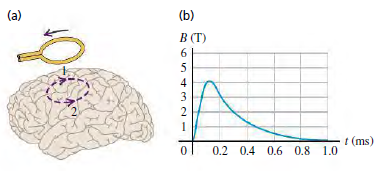Consider the brain tissue at the level of the dashed line to be a series of concentric
Question:
(a) At the center of the dashed line;
(b) At the periphery of the dashed line;
(c) Nowhere€”it will be the same in all concentric circles;
(d) At the center while the stimulating current increases, at the periphery while the current decreases.
Communication in the nervous system is based on the propagation of electrical signals called action potentials along axons, which are extensions of nerve cells (see the Passage Problems in Chapter 26). Action potentials are generated when the electric potential difference across the membrane of the nerve cell changes: Specifically, the inside of the cell becomes more positive. Researchers in clinical medicine and neurobiology cannot stimulate nerves (even noninvasively) at specific locations in conscious human subjects. Using electrodes to apply current to the skin is painful and requires large currents, which could be dangerous.
Anthony Barker and colleagues at the University of Sheffield in England developed a technique called transcranial magnetic stimulation (TMS). In this widely used procedure, a coil positioned near the skull produces a time-varying magnetic field that induces in the conductive tissue of the brain (see part (a) of the figure) electric currents that are sufficient to cause action potentials in nerve cells. For example, if the coil is placed near the motor cortex (the region of the brain that controls voluntary movement), scientists can monitor muscle contraction and assess the connections between the brain and the muscles. Part (b) of the figure is a graph of the typical dependence on time t of the magnetic field B produced by the coil.

Step by Step Answer:

University Physics with Modern Physics
ISBN: 978-0133977981
14th edition
Authors: Hugh D. Young, Roger A. Freedman





